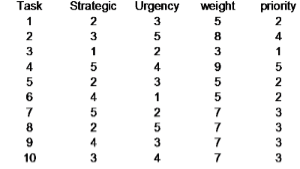Time management - Prioritising objectives part 1
Prioritising objectives part 1
Summation ranking
When we have multiple objectives (targets) we will need to rank them in some fashion so that we can carry them out in the most efficient way possible to reach our goals.
We can use a simple method which examines the longer range ‘strategic’ nature of a task and the shorter range ‘urgency’ of the task.
Strategic
Priority ranking
(using addition)
It doesn’t really matter what values you give the ranking system provided it works for you.
In the above example (see Excel file ‘priority templates’) we are ranking the tasks from 1 to 5, with 1 being the most important and 5 being the least important. You could have 6 levels or 10 levels but it would be up to you to justify them.
The advantage of having more levels is that your analysis will be more detailed and you will have a better chance to rank the objectives.
Clearly, the big disadvantage is the extra effort and time involved. 5 is probably a reasonable starting point.
It is a good idea to define the levels 1 to 5 so that everyone is consistent.
For example:
| Level | Definition |
| 1 | Extremely important |
| 2 | Very important |
| 3 | Quite important |
| 4 | Important |
| 5 | Not important |
Even these values you may wish to clarify with an appropriate example to your circumstances.
This is a simple system but perhaps not too helpful as they are subjective.
Improving these definitions is not easy and will largely depend upon the type of business you are in or what personal goals you are setting.
Urgency
Similarly, for urgency we could have:
| Level | Definition |
| 1 | Needed today as soon as possible |
| 2 | Needed by the end of the day |
| 3 | Needed in the next 2 days |
| 4 | Needed within 1 week |
| 5 | Needed within 2 weeks |
Weighting
We assign a value for each objective as above and ‘add’ the values to give a weighting. We then evaluate the weightings to give an overall ranking. This ranking gives the order of ‘priority’ in which to tackle the tasks.
In the case above we can see that several of the tasks have an equal ranking. This is quite likely to happen with a simple additive ranking system.
To manage this you have several options:
- If they all need to be done on the same day (or within the same time period) it may not be a problem if there is sufficient resource.
- If resource is a problem then we may need to re-examine these tasks and rank them again.
- We could use a slightly more sophisticated system.
We could use a multiplication system, seen next.


